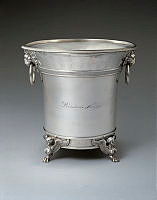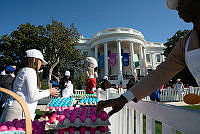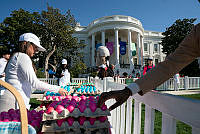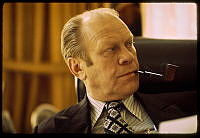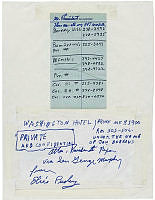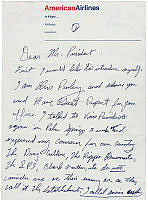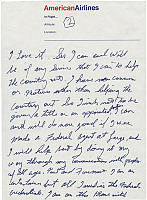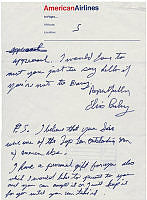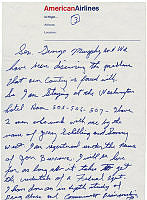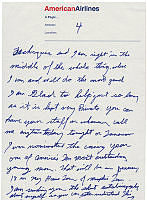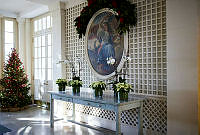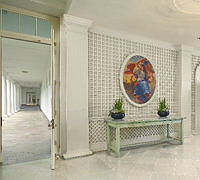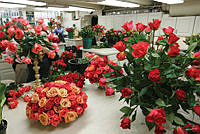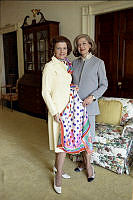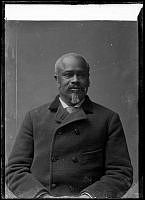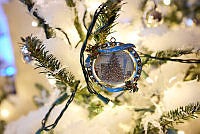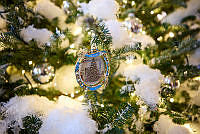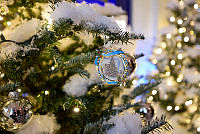Out-Takes: One Photographer's White House Experience
Copyright © Fall 2009 White House Historical Association. All rights reserved under international copyright conventions. No part of this article may be reproduced or utilized in any form or by any means, electronic or mechanical, including photocopying, recording, or by any information storage and retrieval system, without permission in writing from the publisher. Requests for reprint permissions should be addressed to books@whha.org
Gallery
-

White House Executive Chef Walter Scheib posed for the author in the White House kitchen with his assistants Rachel Walker, John Moeller, Cris Comerford, and Adam Collick, September 2001.
White House Historical Association -

Between appointments for portrait photographs, the author Maggie Knaus was asked to take a quick shot of cream-colored roses used by the florist to make centerpieces for the White House dinner celebrating the two-hundredth anniversary of the mansion. The marble capped wall near the North Portico provided an available and appropriate backdrop.
White House Historical Association -

Views of the White House from the north taken just after Christmas in 2005 for use in a new edition of The Living White House.
White House Historical Association -

Barney, President George W. Bush’s Scottie, poses on the South Lawn near the putting green for the photographer in 2003.
White House Historical Association -

Work on The White House: An Illustrated History included portraits of Roland Mesnier, the White House pastry chef, in his kitchen.
White House Historical Association -

Work on The White House: An Illustrated History included portraits of Nancy Clarke, the White House florist, who stopped in the course of inspecting her work in the Diplomatic Reception Room, 2002.
White House Historical Association -

Knaus also photographed Nancy Theis, director of student correspondence, and Dale Haney, horticulturalist, for The White House: An Illustrated History. Theis posed beside the day’s mail, and Haney sat on the South Lawn with Spot and Barney, President Bush’s dogs, 2002.
White House Historical Association -

An early 2002 photo session focused on the process of preparing the rooms of the State Floor for public tours. Here the Blue Room is vacuumed, the carpet is rolled, and stanchions are set up.
White House Historical Association -

A Secret Service agent stands guard on the North Portico; the press reports from the news location, then nicknamed “Pebble Beach,” beside the North Drive (Pebble Beach is now usually called Stonehenge for the new flagstone paving); views of the South Portico, the Rose Garden, and the horseshoe pit; President Bush’s Scottie Barney ambitiously challenges a soccer ball on the South Lawn; and views of the sprinklers on the South Lawn.
White House Historical Association -

Views of the White House Children’s Garden, including the fishpond and children’s hand and footprints, 2002.
White House Historical Association
One who grows up in Washington sees evidence of the nation’s governance firsthand. The caravans of black cars, senators browsing in bookstores, an occasion when the president is there and you shake his hand, a march or demonstration of one sort or another, the thrill of an inauguration day: all are likely experiences. Nothing, however, prepared me for taking my camera to the White House. My first commission for the White House Historical Association began in 2001 when I was hired to photograph the chefs who had prepared the November 2000 dinner to celebrate the two-hundredth anniversary of the White House. My involvement grew to include photography for a number of publications over the years. For a photographer, the thrill of walking through the White House with my camera was like no experience before, even as a lifelong Washingtonian.
My first assignment began with a planning session with the association’s director of publications Marcia Anderson. In early September 2001, she took me through the public tour line to experience the house as the public saw it and to brainstorm for the upcoming shoot. In retrospect, that first working day was an ordinary day at the White House. Throngs of visiting schoolchildren made the building bustle with activity. These had their accompaniment of guides, trained in the stories of the house but also mindful of keeping the flock moving in an orderly way. I scouted the rooms and gardens for likely locations. It was agreed that I would return the following week.
Instead, I returned on September 19 to a very different White House—no tours, no visitors—and wondered if this was a place altered forever. The presence of security personnel was much more evident than before 9/11. Snipers were more obviously present on the roof of the building, and my bags were checked with extra care. There was also an eerie quiet to the building, as tours had been cancelled indefinitely.
If the world was spinning in confusion, I found that those who make the White House tick went about business as usual, mindful indeed of what had happened and the threat that had seemed to hang over the White House on that terrible day but also much occupied with their duties. Each person I photographed had a personal story to tell about the previous week’s events. These they recounted as my camera clicked, and I cannot look at the pictures without remembering what they said. My first shot was of the head chef, Walter Scheib, who insisted on being photographed with his staff, explaining, “We almost died together last week. I do not want to be photographed without them.”

Work on The White House: An Illustrated History included portraits of Nancy Clarke, the White House florist, who stopped in the course of inspecting her work in the Diplomatic Reception Room, 2002.
White House Historical AssociationAcross the deep areaway from the Ground Floor kitchen, Nancy Clarke greeted us amid the wonderful fragrance of cut flowers. She was, until her retirement in the summer of 2009, the White House florist, who began her career during the Carter administration as a volunteer and headed the small, very busy staff in their improbable quarters beneath the North Lawn. The florists’ domain is a small room and a big walk-in refrigerator. Sometimes their assignments spill out into the open air of the areaway, where long tables are set up to hold rows and rows of arrangements destined for perhaps three or four different events in a day. The same arrangements are seldom used even for two events.
Nancy Clarke walked us through the halls and rooms to show us the various arrangements and explained how the first lady usually selects the manner in which the house will be decorated for Christmas. With each stop I was amazed at the small spaces in which all the White House personnel do their work. Flowers are arranged and meals cooked for hundreds of people in rooms not as big as or at least not much larger than those in my own small house. Clearly space does not restrain the quality of the finished products.
The largest grouping of my photographs was taken to illustrate The White House: An Illustrated History, published in 2004. This book, written for students by Catherine O’Neill Grace, is a behind-the-scenes glimpse into what it takes to run the White House on a daily basis. The photographs were intended to document the people who work there, who keep the White House going.

A Secret Service agent stands guard on the North Portico; the press reports from the news location, then nicknamed “Pebble Beach,” beside the North Drive (Pebble Beach is now usually called Stonehenge for the new flagstone paving); views of the South Portico, the Rose Garden, and the horseshoe pit; President Bush’s Scottie Barney ambitiously challenges a soccer ball on the South Lawn; and views of the sprinklers on the South Lawn.
White House Historical AssociationArrangements were made with the chief usher for me to photograph a number of staff members who were representative of aspects of the operation of the White House. I soon became aware that going behind the scenes was a rare privilege. The rules and restrictions at the White House are, of course, many, and on each occasion I was escorted by a member of the Usher’s Office. While we were unable to make candid photographs, the Usher’s Office arranged for us to create as natural a work environment as possible.
I took my photographs over the following years, during all four seasons. The life that went on at the White House outside my “frames” never ceased to fascinate me. I watched with pleasure as Barney, President George W. Bush’s little Scottie, chased tennis balls, which were hit with a tennis racket by the subject before me, Dale Haney, the horticulturist. In addition to his supervision of the 18-acre grounds, Haney was occasional pal to the first family’s dogs, who loved the grassy slopes and the forbidden waters of the swimming pool.
Now and then I felt I was in the way and had to step aside. Haney helped me at Halloween, as he shepherded me off the carpet of grass, warning me—I was four months pregnant—that lawn chemicals were in use. On a cold December afternoon I waited on the South Lawn with my escorts from the association and the Office of the Curator while the sun slowly set, watching for the perfect twilight to capture for a new edition of The Living White House. As the moment of perfect light came, we paused the photo session as official cars suddenly arrived and departed from the South Portico. I often found that magical moments for photographs could not be planned.

Work on The White House: An Illustrated History included portraits of Roland Mesnier, the White House pastry chef, in his kitchen.
White House Historical AssociationPastry chef Roland Mesnier posed in the summer of 2002 for a memorable portrait. In his cramped quarters in a renovated storage pantry, the confectioner and author produced pastries and assorted desserts. He had performed his skill for five presidents. He and his team relayed how, on September 11, they had evacuated the house in a small elevator, hoping the power did not fail. He showed me pictures of his past creations, including a complicated gingerbread White House, and I was amazed at how well three people could work in such a crowded, low-ceilinged space. Chocolates, cookies, and sweet experiments of all kinds filled all except the narrow path that accommodated the maestro and his assistants.
One element in the White House aura that struck me is the presence of children. It is generally an adult world, but even beyond the school tours, children are there. A good distance from the house, down the South Lawn, is the Children’s Garden, a charming little secret place built by Lady Bird Johnson. The imprints in bronze of children’s hands and feet form the pavers, and I wondered if it should not be called the “grandchildren’s garden.” Nancy Theis, who was then responsible for all of the student correspondence addressed to the White House and to President Bush, confirmed this impression. An entire floor of an office building was dedicated to sorting, forwarding, or answering this mighty flood of letters. In response to the terrorist attacks, more than a million letters, cards, and works of art—on that subject alone—flowed in from children worldwide. Several were exhibited in Nancy Theis’s office: posters, quilts, and an American flag created by handprints. The range of emotion ran from fierce patriotism to sadness and hope for the future.
These pages include a collection of images of the White House people and places I witnessed during my assignments. The association has pulled a collection of the out-takes it retained on file from the many rolls of film I shot for each assignment. Most of these images would never have been published—of hundreds of shots only a few ever make it to press.
My subjects are by no means a complete picture. They are representative. The White House is a huge operation, a big mechanism composed of individuals. From the dogs that took the elevator from floor to floor, to the men and women who cared for the house, it was a privilege to see the White House as it truly was, a house, a house that symbolizes so much for so many and whose spirit is alive with the energy of those who work there, even in one of the most trying times in American history.







